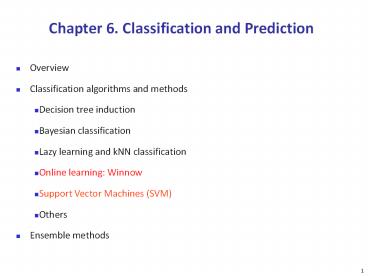Chapter 6. Classification and Prediction - PowerPoint PPT Presentation
Title:
Chapter 6. Classification and Prediction
Description:
Chapter 6. Classification and Prediction Overview Classification algorithms and methods Decision tree induction Bayesian classification Lazy learning and kNN ... – PowerPoint PPT presentation
Number of Views:152
Avg rating:3.0/5.0
Title: Chapter 6. Classification and Prediction
1
Chapter 6. Classification and Prediction
- Overview
- Classification algorithms and methods
- Decision tree induction
- Bayesian classification
- Lazy learning and kNN classification
- Online learning Winnow
- Support Vector Machines (SVM)
- Others
- Ensemble methods
1
2
Online learning Winnow
- PAC learning vs online learning (mistake bound
model) - Winnow an online learning algorithm for learning
linear separator - Prediction same as perceptron
- Perceptron additive weight update
- Winnow multiplicative weight update
3
Winnow
- Learning disjunction
- x1V x2V Vxr out of n variables
- Mistake bound 23r(log n)
- Most useful when lot of irrelevant variables
- Learning r-of-k threshold functions
- Learning a box
- References
- N. Littlestone, Redundant noisy attributes,
attribute errors, and linear threshold learning
using Winnow. Proc. 4th Annu. Workshop on Comput.
Learning Theory, Morgan Kaufmann, San Mateo
(1991) p. 147156 . - Wolfgang Maass and Manfred K. Warmuth, Efficient
Learning with Virtual Threshold Gates
4
Support Vector Machines Overview
- A relatively new classification method for both
separable and non-separable data - Features
- Sound mathematical foundation
- Training time can be slow but efficient methods
are being developed - Robust and accurate, less prone to overfitting
- Applications handwritten digit recognition,
speaker identification,
5
Support Vector Machines History
- Vapnik and colleagues (1992)
- Groundwork from Vapnik-Chervonenkis theory (1960
1990) - Problems driving the initial development of SVM
- Bias variance tradeoff, capacity control,
overfitting - Basic idea accuracy on the training set vs.
capacity - A Tutorial on Support Vector Machines for Pattern
Recognition, Burges, Data Mining and Knowledge
Discovery,1998
Li Xiong
5
6
Linear Support Vector Machines
- Problem find a linear hyperplane (decision
boundary) that best separate the data
7
Linear Support Vector Machines
- Which line is better? B1 or B2?
- How do we define better?
8
Support Vector Machines
- Find hyperplane maximizes the margin
9
Support Vector Machines Illustration
- A separating hyperplane can be written as
- W ? X b 0
- where Ww1, w2, , wn is a weight vector and b
a scalar (bias) - For 2-D it can be written as
- w0 w1 x1 w2 x2 0
- The hyperplane defining the sides of the margin
- H1 w0 w1 x1 w2 x2 1
- H2 w0 w1 x1 w2 x2 1
- Any training tuples that fall on hyperplanes H1
or H2 (i.e., the sides defining the margin) are
support vectors
Data Mining Concepts and Techniques
9
10
Support Vector Machines
For all training points
11
Support Vector Machines
- We want to maximize
- Equivalent to minimizing
- But subjected to the constraints
- Constrained optimization problem
- Lagrange reformulation
12
Support Vector Machines
- What if the problem is not linearly separable?
- Introduce slack variables to the constraints
- Upper bound on the
- training errors
13
Nonlinear Support Vector Machines
- What if decision boundary is not linear?
- Transform the data into higher dimensional space
and search for a hyperplane in the new space - Convert the hyperplane back to the original space
14
SVMKernel functions
- Instead of computing the dot product on the
transformed data tuples, it is mathematically
equivalent to instead applying a kernel function
K(Xi, Xj) to the original data, i.e., K(Xi, Xj)
F(Xi) F(Xj) - Typical Kernel Functions
- SVM can also be used for classifying multiple (gt
2) classes and for regression analysis (with
additional user parameters)
Data Mining Concepts and Techniques
14
15
Support Vector Machines Comments and Research
Issues
- Robust and accurate with nice generalization
properties - Effective (insensitive) to high dimensions
- Complexity characterized by of support vectors
rather than dimensionality - Scalability in training
- Extension to regression analysis
- Extension to multiclass SVM
15
16
SVM Related Links
- SVM web sites
- www.kernel-machines.org
- www.kernel-methods.net
- www.support-vector.net
- www.support-vector-machines.org
- Representative implementations
- LIBSVM an efficient implementation of SVM,
multi-class classifications - SVM-light simpler but performance is not better
than LIBSVM, support only binary classification
and only C language - SVM-torch another recent implementation also
written in C.
Data Mining Concepts and Techniques
16
17
SVMIntroduction Literature
- Statistical Learning Theory by Vapnik
extremely hard to understand, containing many
errors too - C. J. C. Burges. A Tutorial on Support Vector
Machines for Pattern Recognition. Knowledge
Discovery and Data Mining, 2(2), 1998. - Better than the Vapniks book, but still written
too hard for introduction, and the examples are
not-intuitive - The book An Introduction to Support Vector
Machines by N. Cristianini and J. Shawe-Taylor - Also written hard for introduction, but the
explanation about the mercers theorem is better
than above literatures - The neural network book by Haykins
- Contains one nice chapter of SVM introduction
Data Mining Concepts and Techniques
17































